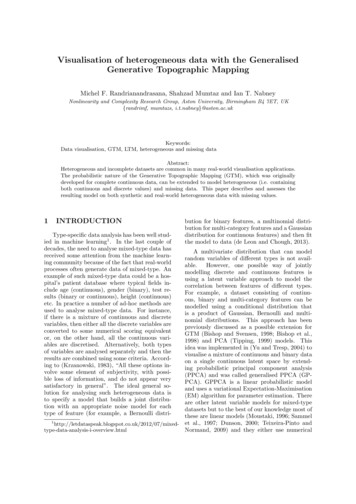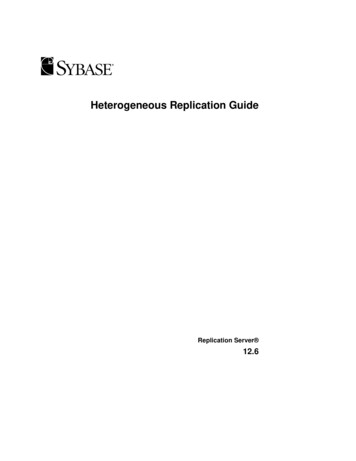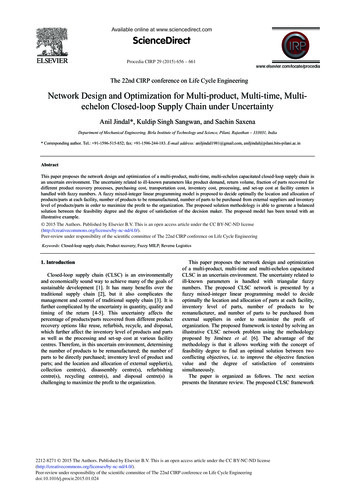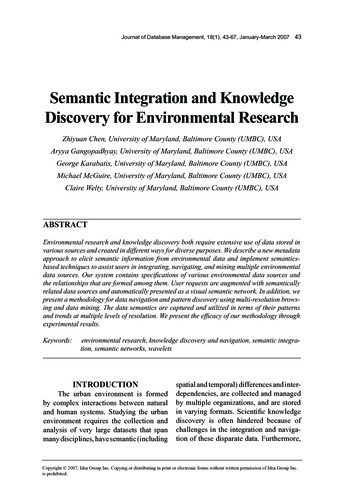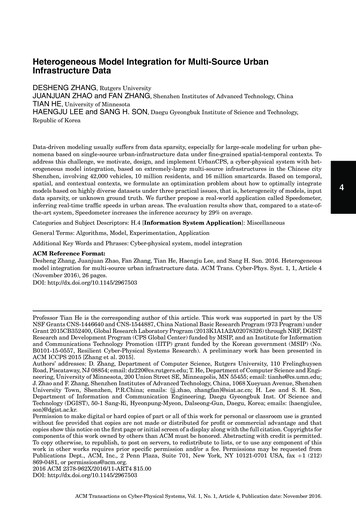
Transcription
Heterogeneous Model Integration for Multi-Source UrbanInfrastructure DataDESHENG ZHANG, Rutgers UniversityJUANJUAN ZHAO and FAN ZHANG, Shenzhen Institutes of Advanced Technology, ChinaTIAN HE, University of MinnesotaHAENGJU LEE and SANG H. SON, Daegu Gyeongbuk Institute of Science and Technology,Republic of KoreaData-driven modeling usually suffers from data sparsity, especially for large-scale modeling for urban phenomena based on single-source urban-infrastructure data under fine-grained spatial-temporal contexts. Toaddress this challenge, we motivate, design, and implement UrbanCPS, a cyber-physical system with heterogeneous model integration, based on extremely-large multi-source infrastructures in the Chinese cityShenzhen, involving 42,000 vehicles, 10 million residents, and 16 million smartcards. Based on temporal,spatial, and contextual contexts, we formulate an optimization problem about how to optimally integratemodels based on highly diverse datasets under three practical issues, that is, heterogeneity of models, inputdata sparsity, or unknown ground truth. We further propose a real-world application called Speedometer,inferring real-time traffic speeds in urban areas. The evaluation results show that, compared to a state-ofthe-art system, Speedometer increases the inference accuracy by 29% on average.Categories and Subject Descriptors: H.4 [Information System Application]: MiscellaneousGeneral Terms: Algorithms, Model, Experimentation, ApplicationAdditional Key Words and Phrases: Cyber-physical system, model integrationACM Reference Format:Desheng Zhang, Juanjuan Zhao, Fan Zhang, Tian He, Haengju Lee, and Sang H. Son. 2016. Heterogeneousmodel integration for multi-source urban infrastructure data. ACM Trans. Cyber-Phys. Syst. 1, 1, Article 4(November 2016), 26 pages.DOI: http://dx.doi.org/10.1145/2967503Professor Tian He is the corresponding author of this article. This work was supported in part by the USNSF Grants CNS-1446640 and CNS-1544887, China National Basic Research Program (973 Program) underGrant 2015CB352400, Global Research Laboratory Program (2013K1A1A2A02078326) through NRF, DGISTResearch and Development Program (CPS Global Center) funded by MSIP, and an Institute for Informationand Communications Technology Promotion (IITP) grant funded by the Korean government (MSIP) (No.B0101-15-0557, Resilient Cyber-Physical Systems Research). A preliminary work has been presented inACM ICCPS 2015 [Zhang et al. 2015].Authors’ addresses: D. Zhang, Department of Computer Science, Rutgers University, 110 FrelinghuysenRoad, Piscataway, NJ 08854; email: dz220@cs.rutgers.edu; T. He, Department of Computer Science and Engineering, University of Minnesota, 200 Union Street SE, Minneapolis, MN 55455; email: tianhe@cs.umn.edu;J. Zhao and F. Zhang, Shenzhen Institutes of Advanced Technology, China, 1068 Xueyuan Avenue, ShenzhenUniversity Town, Shenzhen, P.R.China; emails: {jj.zhao, zhangfan}@siat.ac.cn; H. Lee and S. H. Son,Department of Information and Communication Engineering, Daegu Gyeongbuk Inst. Of Science andTechnology (DGIST), 50-1 Sang-Ri, Hyeonpung-Myeon, Dalseong-Gun, Daegu, Korea; emails: {haengjulee,son}@dgist.ac.kr.Permission to make digital or hard copies of part or all of this work for personal or classroom use is grantedwithout fee provided that copies are not made or distributed for profit or commercial advantage and thatcopies show this notice on the first page or initial screen of a display along with the full citation. Copyrights forcomponents of this work owned by others than ACM must be honored. Abstracting with credit is permitted.To copy otherwise, to republish, to post on servers, to redistribute to lists, or to use any component of thiswork in other works requires prior specific permission and/or a fee. Permissions may be requested fromPublications Dept., ACM, Inc., 2 Penn Plaza, Suite 701, New York, NY 10121-0701 USA, fax 1 (212)869-0481, or permissions@acm.org.2016 ACM 2378-962X/2016/11-ART4 15.00DOI: http://dx.doi.org/10.1145/2967503ACM Transactions on Cyber-Physical Systems, Vol. 1, No. 1, Article 4, Publication date: November 2016.4
4:2D. Zhang et al.1. INTRODUCTIONThe recent advance of urban infrastructures increases our ability to collect, analyze,and utilize big infrastructure data to improve urban phenomenon modeling [Zhenget al. 2014]. Numerous data-driven models have been proposed based on theseinfrastructure data to capture urban dynamics [Aslam et al. 2012; Shang et al. 2014;Yuan et al. 2011a]. However, although each infrastructure produces abundant data, almost all resultant models suffer from data sparsity [Zheng et al. 2014]. This is becauseit is almost impossible to collect complete data about a particular phenomenon underfine-grained spatial-temporal contexts. For example, traffic speeds can be modeled byGPS data from taxicabs [Aslam et al. 2012], but under fine-grained spatial-temporalcontexts, such a speed model suffers from data sparsity. As shown by our empiricalanalysis on the Chinese city Shenzhen, given a middle-length time slot of 5min during24h, 57% of its 110,000 road segments on average do not have any taxicabs, whichleads to data sparsity.In this work, we argue that with increasing updates of urban infrastructures, oneurban phenomenon can be separately modeled by many heterogeneous infrastructuredatasets. For example, a traffic speed can be directly modeled by vehicle GPS data andloop detector data [Aslam et al. 2012] or indirectly modeled by cellphone and transportation smartcard data [Isaacman et al. 2012]. Integrating these relevant yet heterogeneous models can provide complementary predictive powers by combining the expertiseof heterogeneous infrastructures, which is used to address data sparsity issues aboutsingle infrastructures. Although many effective models have been proposed based oninfrastructure data, they are typically based on single-source data, for example, taxicabGPS [Aslam et al. 2012], cellphone data [Isaacman et al. 2012], bus data [Bhattacharyaet al. 2013], and subway data [Lathia and Capra 2011]. Due to various technical andlogistical reasons, little work, if any, has been done to integrate single-source heterogeneous models into a unified multi-source model based on large-scale infrastructuredata (TB-level data) to address practical issues, for example, sparse data, for real-worldapplications. We provide a detailed survey of existing work in Section 6.To this end, we motivate and design UrbanCPS, a Cyber-Physical Systems (CPS)system with a generic heterogeneous-model integration based on extremely-large infrastructure data. In UrbanCPS, we implement five heterogeneous models based on a14,000-taxicab network, a 15,000-truck network, a 13,000-bus network, a 10-millionuser cellular network, and an automatic fare-collection system with 17,000 smartcardreaders and 16 million smartcards in Shenzhen. With these five highly diverse heterogeneous models, we propose a model-integration technique to address their data sparsity, for example, integrating traffic-speed models based on vehicles data and urbandensity models based on cellphone data. However, we face three challenges as follows.(1) Among all heterogeneous models, some models are only indirectly relevant to aparticular phenomenon of interest, for example, an urban-density model is onlyindirectly revelent to traffic speeds. Thus, it is challenging to effectively integratedirectly relevant models with indirectly relevant models due to their heterogeneity.(2) Indirectly relevant models normally cannot output a measurement about phenomena of interest directly. Thus, even with complementary knowledge from indirectlyrelevant models, it is a non-trivial problem to solve data sparsity for directly relevant models.(3) During a model integration, different models have different weights under differenttemporal, spatial, and contextual conditions, and the optimal weights are usuallyobtained by regression with the ground truth. But the ground truth of urban scalephenomena is almost impossible or really expensive to be obtained.A unique combination of the above three challenges makes our work significantly differ from the previous model integration, where integrated models are oftenACM Transactions on Cyber-Physical Systems, Vol. 1, No. 1, Article 4, Publication date: November 2016.
Heterogeneous Model Integration for Multi-Source Urban Infrastructure Data4:3homogenous and based on complete data with known ground truth. The key contributions of the article are as follows:—We propose the first generic CPS system UrbanCPS with heterogeneous model integration based on metropolitan-scale data. To our knowledge, the integrated modelshave by far the highest standard for urban modeling in two aspects: (i) modelingbased on the most complete infrastructure data including cellular, taxicab, bus, subway, and truck data for the same city and (ii) modeling based on the largest residential and spatial coverage (i.e., 95% of 11 million permanent residents and 93%of 110,000 road segments in Shenzhen). The sample data are given in Sample Data[2015].—We theoretically formulate an optimization problem to integrate heterogeneous models. We propose a technique to dynamically measure heterogeneous-model similarity on phenomena of interest under different temporal, spatial, and contextualconditions to address three practical issues as follows: (i) how to integrate indirectly relevant heterogeneous models, (ii) how to use an integrated model to address data sparsit, and; (iii) how to assign weights to different models without aregression process based on the ground truth. In particular, we design a techniquebased on context-aware tensor decomposition to integrate multiple models with datasparsity.—We design and implement a real-world application called Speedometer, which infersreal-time traffic speeds in urban areas based on an integration of five models built ontaxicab, bus, truck, cellphone, and smartcard-reader networks. We test UrbanCPSbased on a comprehensive evaluation with 1TB real-world data in Shenzhen. Theevaluation results show that, compared to a current system, UrbanCPS increasesthe inference accuracy by 29% on average.We organize the article as follows. Section 2 gives our motivation. Section 3 presentsthe UrbanCPS. Section 4 describes our model integration based on Bayesian modelaveraging and tenser decomposition. Section 5 validates UrbanCPS with a real-worldapplication, followed by the related work and the conclusion in Sections 6 and 7.2. MOTIVATIONTo show our motivation, we compare two traffic-speed models built on large-scaleempirical data we collected in Shenzhen. The first model is called SZ-Taxi [TransportCommission of Shenzhen Municipality 2014], which is a real-world system deployedand maintained by the Shenzhen Transport Committee to infer real-time traffic speedsbased on taxicab GPS data in Shenzhen. The second model is called Travel SpeedEstimation (TSE) [Shang et al. 2014], which is a state-of-the-art traffic model in theresearch community based on vehicle GPS data. We feed our bus and truck GPS data toTSE and obtain two models called TSE-Bus and TSE-Truck, respectively. The detailsare given in Section 5.2. As in Figure 1, we compare three models based on taxicab,bus, and truck data to the ground truth on a major road segment in Shenzhen calledShahe Road in 5min slots during a regular Monday.The ground truth is obtained by loop detectors, which are deployed in limited intersections of a city to obtain the real-time average traffic speeds. Loop detectors aremostly managed by city transportation agencies. Due to costs and deployment efforts,most cities, including Shenzhen, only install these detectors on major intersections orroad segments instead of urban-scale deployment. The details about loop detectors aregiven in the evaluation section. Note that although different kinds of vehicles have different speeds on the same road segment, for example, a bus may have a different speedfrom a passenger car [Garg et al. 2014b], we focus on developing an average speed modelfor generic traffic, similar to other state-of-the-art models [Transport Commission ofShenzhen Municipality 2014; Shang et al. 2014].ACM Transactions on Cyber-Physical Systems, Vol. 1, No. 1, Article 4, Publication date: November 2016.
4:4D. Zhang et al.Fig. 1. Inferred traffic speeds by three models.In general, all three models have data sparsity issues, that is, among a total of 2885min slots, SZ-Taxi, TSE-Bus, and TSE-Truck have data on 87, 49, and 39 slots, thatis, 30%, 17%, and 14%, respectively. If the data are all complete for all three models,then we should have 24 points for every model, that is, a total of 72 points, for everyred box covering a 2h period, but we have much fewer than 72 points, as shown inFigure 1. (i) SZ-Taxi has a major data sparsity issue during the early morning when notaxicabs are on this road segment. Further, it typically overestimates the speed at nightsince taxicab drivers typically drive much faster than regular drivers at night whenpassengers are few, but it underestimates the speed in the daytime due to frequentstopping for pickups and dropoffs as well as long wait times for passengers. (ii) TSEBus has sparse data for the nighttime when the bus service is not available and insome regular daytime. Further, it underestimates the speed in the non-rush hour dueto frequent stops, but it overestimates the speed in the rush hour because of dedicatedfast traffic lines for bus only. (iii) TSE-Truck has sparse data in the morning andevening rush hour, because trucks are forbidden to use several major roads duringthe rush hour to relief traffic congestion. Even for the time period where trucks areallowed, it still has this issue. Also, it usually underestimates the speed during othertimes due to the speed limit of trucks. Note that this road segment was selected as 1of 10 major road segments in Shenzhen, but we still face major data sparsity issues,which are much worse on other small road segments where there are fewer taxicabs,buses, or trucks, as shown in Section 3.2.A seemingly promising solution is to integrate these three models to address datasparsity issues from a homogenous complimentary view. However, such a straightforward homogenous-model integration may still face data sparsity issues due to theirinherent homogeneity, for example, all three models have incomplete data in commonslots in the red boxes. In this work, we address this challenge by introducing otherheterogeneous models (e.g., urban-density models) based on different datasets (e.g.,cellphone data) under the observation that the traffic speed is correlated with urbandensity in same spatial-temporal contexts [Cox 2015], as shown by Figure 2, where weplot the density and traffic speed on a road segment in Shenzhen on a regular Monday.We clearly found that when the traffic density goes up, the traffic speed goes down. Itmotivates us to combine density models with speeds models to infer traffic speeds. Infact, in the civil engineering community, such a phenomenon is called the fundamentaldiagram of traffic flow [Wikipedia 2016]. There has been some previous work to empirically quantify this fundamental diagram [Sen et al. 2013a] but in a small scale withonly traffic data. In contrast, our work is to integrate models driven by vehicle GPSdata, cellphone data, and smartcard data.ACM Transactions on Cyber-Physical Systems, Vol. 1, No. 1, Article 4, Publication date: November 2016.
Heterogeneous Model Integration for Multi-Source Urban Infrastructure Data4:5Fig. 2. Correlation between speed and density.Fig. 3. Urban Cyber Physical System.However, determining a way to combine these heterogeneous models for the sameobjective is challenging. In this work, we propose an integration technique in a referenceimplementation of an extremely large CPS system, which is presented as follows.3. URBAN CYBER PHYSICAL SYSTEMBroadly, a CPS can be considered a system of systems. Therefore, in this work, we consider a set of urban infrastructure systems (for example, cellular, taxicab, bus, subway,and truck networks) as a Urban Cyber Physical System (UrbanCPS) from a broad perspective: Any device in urban infrastructures is considered a pervasive sensor in UrbanCPS if it generates data that can be used to build a model to describe phenomena ofinterest. Built on an integration of models based on multiple data sources, UrbanCPSprovides unseen urban dynamics under extremely fine-grained spatio-temporal resolutions to support real-world applications, which cannot be achieved by any model froma single data source in isolation, for example, a monolithic infrastructure.In Figure 3, we outline UrbanCPS with four components, that is, Data Collection,Model Generation, Model Integration, and Model Utilization. These four componentsspan the whole data-processing chain in UrbanCPS.As in Figure 3, we provide a road map for the rest of article as follows. (i) InSection 3.1, we first introduce the data collection where we individually collect multiplesource data from urban infrastructures of Shenzhen. (ii) In Section 3.2, we generatevarious heterogeneous models based on collected single-source data. (iii) In Section 4,we effectively combine these heterogeneous models by our model integration based ontheir similarity and domain knowledge. (iv) In Section 5, to close the control loop, wepropose an application to estimate real-time traffic speeds based on integrated modelsand other supporting data, for example, map data and urban partition data. We envision that urban residents would use this application to find efficient routes, whichACM Transactions on Cyber-Physical Systems, Vol. 1, No. 1, Article 4, Publication date: November 2016.
4:6D. Zhang et al.in turn provides feedback to urban infrastructures. As a result, with the highlights onextremely-large data collection and highly generic heterogeneous model integration,UrbanCPS builds an architectural bridge between multiple domain-independent urbaninfrastructures and real-world knowledge output tailored by applications.3.1. Data CollectionIn our project, we have been collaborating with several service providers and theShenzhen Transport Committee (STC) for real-time access of urban infrastructures.In Figure 3, we consider five kinds of devices in this version of implementation, whichdetects urban dynamics from complimentary perspectives.—Cellphones are used to detect cellphone users’ locations at cell tower levels basedon call detail records. We utilize cellphone data through two major operators inShenzhen with more than 10 million users. The cellphone data give 220 millionlocations per day.—Smartcard Readers are used to detect locations of a total of 16 million smartcardsused to pay bus and subway fares. These readers capture more than 10 million ridesand 6 million passengers per day. We study reader data from STC, which accessesreal-time data feeds of a company that operates the smartcard business.—Buses are used to detect real-time traffic and bus passengers’ locations by crossreferencing data of onboard smartcard readers for fare payments. We study bus datathrough STC, to which bus companies upload their bus status in real time, accountingfor all 13,000 buses generating two GPS records per minute.—Taxicabs are used to detect real-time traffic and taxicab passengers’ locations basedon taxicab status (i.e., GPS and occupancy). We study taxicab data through STC, towhich taxicab companies upload their taxicab status in real time, accounting for all14,000 taxicabs generating two GPS records per minute.—Trucks are used to detect real-time traffic by logging real-time GPS locations ofa fleet of 15,000 freight trucks, which travel within Shenzhen and around nearbycities. We study this truck network through a freight company that installs GPSdevices on all these trunks for daily management. Every truck uploads its real-timeGPS location and driving speed back to the company server every 15s on average,which then are routed to our server.Since our article concentrates on system aspects, we briefly introduce our data relatedissues due to space limitation. We establish a secure and reliable transmission mechanism, which feeds our server the above data collected by STC and service providerswith a wired connection.As in Figure 4, we have been storing a large amount of data to generate single-sourcemodels. Their spatial granularity is given in Figure 5 where commercial vehicles, thatis, trucks, buses, and regular and electric taxis, generate data at road segment levelsbut bus smartcards, subway smartcards, and cellphones generate data at station levels.Such big data require significant effort for the daily management. We utilize a 34TBHadoop Distributed File System (HDFS) on a cluster consisting of 11 nodes, each ofwhich is equipped with 32 cores and 32GB RAM. For daily management and processing,we use the MapReduce-based Pig and Hive. Due to the extremely large size of ourdata, we have been finding several kinds of errant data, for example, missing data,duplicated data, and data with logical errors, and thus we have been conducting adetailed cleaning process to filter out errant data on a daily basis. We protect theprivacy of residents by anonymizing all data and presenting models in aggregation. Inshort, our endeavor of consolidating the above data enables extremely large-scale finegrained urban phenomenon rendering based on existing single-source models, whichis unprecedented in terms of both quantity and quality as shown in the following.ACM Transactions on Cyber-Physical Systems, Vol. 1, No. 1, Article 4, Publication date: November 2016.
Heterogeneous Model Integration for Multi-Source Urban Infrastructure Data4:7Fig. 4. Datasets from model generation.Fig. 5. Data granularity.3.2. Model GenerationFellow researchers have proposed many effective single-source models [Zheng et al.2014], so we restrain ourselves from developing new models. Instead, we directly useour data to generate single-source models based on existing methods.3.2.1. Model Summary. We implement two kinds of models based on the data collectedin UrbanCPS. (i) Speed Models: including M T , M B, M F , which use GPS data from taxicab, bus, and freight truck networks individually to estimate real-time traffic speeds.They are implemented similarly according to a state-of-the-art speed model, TSE,which uses historical and real-time vehicle data as well as contexts (for example, physical features of roads) for a collaborative filtering [Shang et al. 2014]. In addition, weconsider all vehicles as a single fleet and feed its data to TSE to obtain a new model M V .(ii) Density Models: including MC and M S , which use the Cellphone and Smartcarddata to estimate real-time urban density (i.e., count of residents). MC is based on aACM Transactions on Cyber-Physical Systems, Vol. 1, No. 1, Article 4, Publication date: November 2016.
4:8D. Zhang et al.Table I. Heterogeneous ModelsModelNameMTMBMFMVMCMSSpatialResolution87% of Roads59% of Roads45% of Roads93% of Roads17,859 Towers10,442 ousResidentCoverageN\AN\AN\AN\A95%55%Fig. 6. Covered road segments.population density model that predicts future Call detail record (CDR) records basedon the previous CDR records to indicate the density [Isaacman et al. 2012]. M S is basedon a Gaussian process-based predictive model that uses contexts, for example, time ofday and day of week, to infer transit passenger density [Bhattacharya et al. 2013]. Weprovide a summary of these models in Table I based on their results in one day. During1 day, based on the GPS uploading speeds and traveling patterns, M T , M B, M F , andM V cover 87%, 59%, 45%, and 93% of all 110,000 road segments in Shenzhen. During 1day, MC covers 95% of 11 million residents and produces their locations as 1 of 17,859cell towers when they use their phones. M S covers 55% of all residents and producestheir locations as 1 of 10,442 transit stations when they use their smartcards.3.2.2. Data Sparsity in Fine Granularity. Although all these models have comprehensivedaily data, real-world applications typically require knowledge under fine-grainedspatial-temporal contexts [Aslam et al. 2012; Shang et al. 2014; Yuan et al. 2011a]where all these models experience data sparsity issues.Based on the historical data, we pick the first weekday after a national holiday, andon this particular day, all these infrastructure systems generate the biggest data interms of volumes compared to other days.We show the percentage of segments where speeds can be captured by speed modelsin 5min slots in Figure 6. We found that these models capture a low percentage ofsegments under 5min slots, for example, even for M V based on all vehicle data, we onlyhave 49% of road segments on average with vehicles, which leads to data sparsity.Similarly, we show the number of residents captured by MC and M S in Figure 7,where the result for M S is shown by a factor of 10 in order to show the fluctuation.We found that these two density models also have data sparsity issues due to hightotal population in Shenzhen, for example, among 11 million permanent residents, MCcan only capture 1 million of them at most during a 5min slot around 15:00, accountingfor only 9% of all residents. MC can only capture 80,000 of them at most during a 5minslot of the morning rush hour, accounting for only 0.7% of all residents.ACM Transactions on Cyber-Physical Systems, Vol. 1, No. 1, Article 4, Publication date: November 2016.
Heterogeneous Model Integration for Multi-Source Urban Infrastructure Data4:9Fig. 7. Covered urban residents.3.2.3. Opportunity for Model Integration. In this work, we found that although all thesemodels have data sparsity issues, MC and M S have more complete data than others,for example, for every 5min slot in both MC and M S , we have density data at celltower and transit station levels. Therefore, by resetting their spatial granularity toroad segment levels (that is, the details are given in Section 5.2), density models MCand M S are capable of providing complimentary knowledge for speed models M T , M B,and M F , which have severe data sparsity issues on road segment levels, for example,if a speed model does not have GPS data about a road segment during a time slot, weinfer missing GPS data based on historical GPS data and the data from road segmentswith similar urban density, shown by our model integration as follows.4. MODEL INTEGRATIONWe introduce our integration technique by combining models directly or indirectly relevant to phenomena of interest (hereafter direct and indirect models for conciseness).In this work, we simply identify a model as a direct model to an urban phenomenonif it is based on the data with direct measurements of this phenomenon, for example, a model based on taxicab data is a direct model for the phenomenon of trafficspeeds, because taxicab data have direct measurements of speeds. But a model basedon cellphone data is only an indirect model for speeds because it does not have directmeasurements on speeds. As discussed before, we also need these indirect models inour integration, because they often provide complimentary knowledge to address datasparsity issues of direct models. Note that direct and indirect models differ from classicsupervised and unsupervised models in data mining, which are both direct models inour context since they are based on data with direct measurements for phenomena ofinterest.4.1. Problem FormulationLet xt·s be an urban phenomenon we want to characterize associated with a temporalcontext t and a spatial context s, and let y be a class label, where xt·s and y are selectedfrom a phenomenon space X and a label space Y. Based on K different data sourcesin various urban infrastructures, we have a set of K models, that is, from M1 to M K ,and each of them is independently formulated based on a corresponding data source.For example, in our later application, xt·s is a traffic speed on a road segment s duringa time period t, y is a label of 20km/h, and M1 is a model based on taxicab data andassigns a particular label y to xt·s .ACM Transactions on Cyber-Physical Systems, Vol. 1, No. 1, Article 4, Publication date: November 2016.
4:10D. Zhang et al.Formally, based on the Bayesian model averaging approach, we have the probabilitydistribution for y as follows:P(y xt·s ) K P(y Mk, xt·s ) P(Mk xt·s ),(1)k 1where P(y Mk, xt·s ) is the prediction made by Mk regarding to xt·s ; P(Mk xt·s ) is considered as a model weight for a particular model Mk given a particular urban phenomenonxt·s under with a temporal context t and a spatial context s.To integrate different models in small-scale systems, Equation (1) can be directlyused. In particular, P(y Mk, xt·s ) can be accurately obtained by a direct model Mk directly relevant to the phenomenon of interest xt·s , based on the complete data. Further,the ground truth of conditional probability P(y yi xt·s ) can also be measured and thenused by a regression process to obtain the optimal weight P(Mk xt·s ) for a model Mkgiven xt·s . However, to integrate models in our UrbanCPS with Equation (1), we facethree challenges to directly obtain the two factors, that is, P(y Mk, xt·s ) and P(Mk xt·s ).First, the models in our UrbanCPS are mostly heterogeneous and based on the datagenerated by service providers primarily for their own benefits, and thus these modelsmay be only indirectly relevant to the phenomenon of interest. For example, a modelbased on cellphone data can be used to directly infer cellphone usage and thus urbandensity. But this model cannot be directly used to infer a traffic speed, though they aresomehow related, because normally the higher the residential density, the lower thetraffic speed, as shown in our Section 2. As a result, given
have by far the highest standard for urban modeling in two aspects: (i) modeling based on the most complete infrastructure data including cellular, taxicab, bus, sub-way, and truck data for the same city and (ii) modeling based on the largest resi-dential and spatial coverage (i.e., 95% of 11 million permanent residents and 93%

